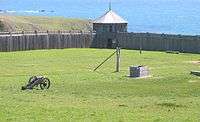Fort Ross
Fort Ross is a State Historical Park in the North Coast of California. Although fairly remote, it is well worth a visit as you will become one of the few people who know about the Russian contribution to the colonizing of California.
Understand
The fort is in a remote area with little food or services. There is no cell phone service in this region.

History
Fort Ross was a Russian fur trade outpost in what is now Sonoma County, California. It was established by the Russian-American Company in 1812 and sold to John Sutter in 1841, owing to the depletion of the local population of fur-bearing marine mammals, and to the decreased strategic importance of a supply base for Russia's Alaskan colonies following the Convention of February 28, 1825 with the British. It was the southernmost outpost of a Russian presence in the Pacific Northwest and Alaska. The fort and the surrounding settlement was home to Russians, Aleut hunters in their employment, and native Kashia Pomo. This unique site has been the subject of intensive archaeological investigation. It is designated a National Historic Landmark.
Landscape
The fort is on a small peninsula that juts out into the pacific ocean. The edge of the peninsula forms a large bluff (20 m) that can make it somewhat difficult to gain access to the beaches. Large coastal mountains covered in a thick forest tower over the park.
Flora and fauna
There is a wealth of wildlife activity in the region, particularly on the isolated beaches that run below the bluff. Sea otters, sea lions and many impressive sea birds are abundant in the area. Whales are also known to migrate along the coast.
Much of the beaches are covered in large piles of kelp (seaweed) with the occasional tide pool near by. It makes for a great place to explore for wildlife but not great for beach swimming.

Climate
Warm in summer, rainy and foggy (and occasionally sunny) in winter. Dress in layers, and if you are planning on swimming, expect the Pacific Ocean to be cold.
Get in
The most scenic way to get to Fort Ross from San Francisco is by driving up the Pacific Coast Highway (Highway 1).
Fees and permits
A day-use vehicle permit costs $8.
Get around
Expect a bit of a walk. From the visitor center and parking lot down to the fort proper it is a quarter mile walk. To get down to the beaches expect about a 20- to 30-minute hike.
See
- Old Russian Fort
- Russian Burial Grounds
- Russian Orthodox Church
- Visitor Center (nicely done)
- Whales
- Sea Otters
- Sea Lions
Do
Hike along the beach
Cultural Heritage Day - last Saturday in July every year, 10AM-5PM. The fort comes alive with costumed reenactors, this is a fun way to see the fort as it was in its heyday.
Buy
There is a souvenir shop at the visitor center where you can get some great Russian memorabilia such as post cards with a historical California/Russia post card.
Eat
The fort does not offer much in the way of food so be sure and pack a lunch or expect to drive out of the park to a restaurant or local store to get some food.
Drink
Sleep
There are motels located about a half mile drive further up Highway 1. You can also just camp in your car, although it is not recommended that you do this in the Fort Ross parking lot.
Camping
Basic camping facilities are available to the south about a 2-min drive at The Reef Campground. (Pit toilets, camp sites, dirt road, pay phone. Cell phones don't work here.) Open most of the year. Other camp grounds are to the north, 10-20 miles.
Back country
The coastal mountains that tower over the fort have some great hiking trails. Just ask at the visitors center. there are also hiking trails along the bluffs to the north and south of the fort.
Stay safe
Go next
| Routes through Fort Ross |
| Fort Bragg ← Sea Ranch ← | N |
→ Jenner → San Francisco |